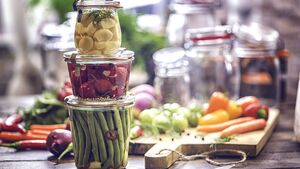Living Greener: More to salad than lettuce

Many foods that do not taste great by themselves are rescued by the other ingredients in a salad
AS children my brothers and I loved our rare family outings to a salad bar; foods like artichokes, water chestnuts and sprouts were exotic to us, and we set upon them like locusts.
As we piled mountains of garnishes onto our plates, we realised we loved salad – we just hated lettuce.
For some reason, “salad” in the modern Anglo world has come to mean iceberg lettuce, one of the few vegetables with almost no taste or nutritional value; it’s no wonder that so many people think of eating fresh vegetables as they would going to the dentist.
“Salad” can mean any raw food — and many cooked ones — held together with sauce. Like soup or quiche, salads can re-use leftovers meat, fruit, herbs, dried bread, seeds, sprouts, eggs, beans, nuts, berries, pasta or pickles – and mix them with whatever edible parts are flowering, budding, leafing, bulging or shooting in the nearest field, garden or woodland.
Because of our late spring, only now are we seeing the first hawthorn shoots, along with the first dandelions, cowslips and primroses.
Soon linden leaves can be taken right off the tree and chopped for salad, along with daisies, sorrel, parsley, bernard and clover.
Then the red lettuces, green lettuces, mizuna and rocket will come up, along with herbs like chives, borrage and coriander, and weeds like fat hen and Good King Henry.
By June the kohlrabi, carrots and fennel could be uprooted, cleaned and grated.
In autumn the nasturtium, spinach and cabbages are ready, and the dandelions and clover are still coming, and in winter we will turn to chicory and roots, while still growing other vegetables in the greenhouse.
Many people think root crops must be cooked, but I enjoy shredding them into salads. Beetroot makes a great mix with feta cheese in a sauce of soy sauce, spices, olive oil and vinegar.
Celeriac, a celery relative bred for its bulbous roots, can be finely grated and mixed in a tangy sauce with lemon, sesame oil and cayenne pepper.
Many people buy bottles of salad dressing from the store, but you can make your own dressings at home for a fraction of the price, and they are likely to be healthier and taste better. We make ours from home-made yogurt, which we make by putting a bit of plain natural yogurt as a starter into warmed milk and leaving it overnight in hot water. Or you can make your own mayonnaise by whipping 2 egg yolks, 20ml of lemon juice and a pinch of salt together in a bowl and whisking the mix as you slowly pour in a cup of vegetable oil.
Many foods that do not taste great by themselves are rescued by the other ingredients in a salad; bitter dandelion leaves in spring, for example, and tart elderberries in the autumn.
Other foods change their flavour when treated; we slice cucumbers and salt them to extract the astringent taste, soak the slices in water to wash off the salt, squeeze the water out of them, and mix them in a dill-and-yogurt dressing.
Traditionally heavy dishes like potato salad can be made surprisingly light for health or hot weather.
We make a very light summer potato salad with a small pot — say, 500ml — of boiled waxy potatoes, and similarly-sized volumes of diced apples, diced hard-boiled eggs, and thinly-sliced celery.
Mix about 300 ml of dressing — for example, yogurt and lemon juice, mixed with lemon zest, sesame oil, cayenne powder and pepper, along with chopped mint, dill and chives.
As soon as the potatoes are boiled, drained and chopped — when they are still hot — mix them into the dressing, and they will absorb the liquid as they cool.
Then mix in the cold apples, eggs and celery for an all-in-one meal. This is a general recipe; experiment until you get it right for you.
As fuel and electricity become more sporadic or expensive, we might want to get our hands used to preparing, and our bellies used to digesting more foods that don’t require them.
It makes a convenient way to slowly introduce a wider variety of species, flavours and techniques, and to discover the joys of finding food for free.





